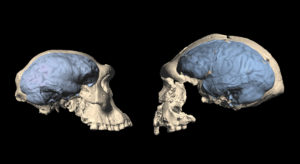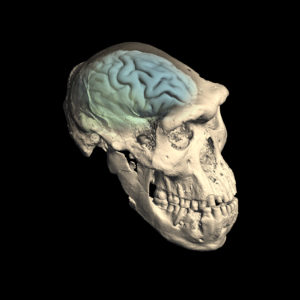
American Association for the Advancement of Science—Modern human-like brains evolved comparatively late in the genus Homo and long after the earliest humans first dispersed from Africa, according to a new study. By analyzing the impressions left behind by the ancient brains that once sat inside now fossilized skulls, the authors discovered that the brains of the earliest Homo retained a primitive, great ape-like organization of the frontal lobe. The findings challenge the long-standing assumption that human-like brain organization is a hallmark of early Homo and suggest that the evolutionary history of the human brain is more complex than previously thought. Our modern brains are larger and structurally different than those of our closest living relatives, the great apes, particularly in frontal lobe areas involved with complex cognitive tasks like toolmaking and language. However, when these key differences arose during human evolution remains poorly understood. One of the major challenges in tracking brain evolution in early hominid species is that brain tissues rarely fossilize. As a result, much of what is known is derived from shape and structures on the surface of the brain cases of rare, fossilized skulls. Representations of these surfaces – or endocasts – can reveal patterned imprints representing the folds and indentations of the brain and its surrounding vasculature. Using a collection of well-preserved fossil Homo crania from the Dmanisi site in the modern-day nation of Georgia and a comparative sample of others from Africa and Southeast Asia, Marcia Ponce De León and colleagues tracked key changes in brain organization of early Homo from roughly 1.8 million years ago (Ma). They found that the structural innovations in the cerebral regions thought to allow for many of humans’ unique behaviors and abilities emerged later in the evolution of Homo. According to Ponce De León et al., the findings suggest that modern human-like brain reorganization – which was probably in place by 1.7-1.5 Ma – was neither a requisite trait for genus Homo, nor a prerequisite for early Homo’s dispersals into Europe and Asia. In a related Perspective, Amélie Beaudet discusses the study in greater detail.
___________________________

Skull of early Homo from Dmanisi (specimen D4500) showing internal structure of the brain
case, and inferred brain morphology. M. Ponce de León and Ch. Zollikofer, University of Zurich
___________________________

Skulls of early Homo from Dmanisi, Georgia (specimen D4500, left) and Sangiran, Indonesia
(specimen S17, right). Virtual fillings of their braincases permit inferences on brain organization
(blue). Brains of Homo evolved from ape-like (D4500) to human-like (S17) in the time between
1.7 – 1.5 million years ago. M. Ponce de León and Ch. Zollikofer, University of Zurich
___________________________
Article Source: AAAS news release
This research appears in the 9 April 2021 issue of Science. Science is published by AAAS, the nonprofit science society.
___________________________
Advertisement





